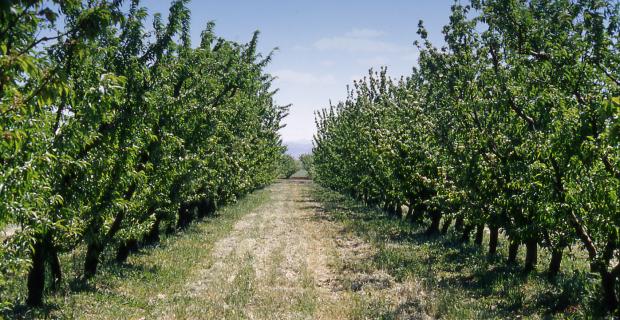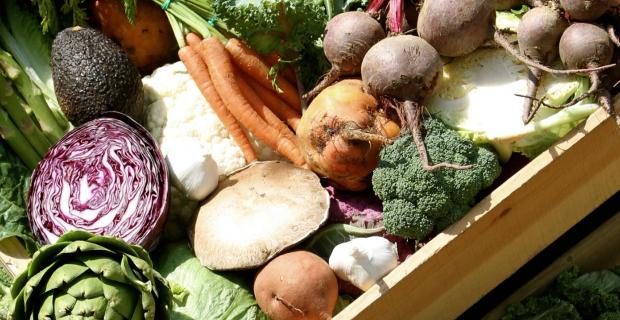By Feeding Young People Well, We Nourish Our Own Future

Lunchtime at Goleta Valley Junior High starts at 12:07. Within 28 minutes, 700 students have to be "fed" before returning to classes.
The scene is pandemonium. Students are either standing in lines, clustered in small bands, or racing around as if lost. The lunch tables are folded and stacked with their accompanying chairs; students eat outside while standing up (a food fight a couple years ago resulted in the administration's removing any opportunity for students to sit down and eat together).
The cool stainless tubular slides that once carried plastic trays of hot food dished out by hair-netted women in starched white uniforms remain. But no milk machines squirt columns of regular or chocolate milk; no bottom-heated tables keep mashed potatoes or lasagna warm; no fishcakes wait in stacks; no coleslaw sits at the ready; no clam chowder simmers, ready to be ladled into waiting bowls.
The heating table's large pans are now filled with prepackaged barbecued beef sandwiches and cheeseburgers prepared at anonymous kitchens, miles away, with ingredients from U.S. government commodities programs. On the wall a faded sign reads, "Fruits and vegetables are always in season. Whether they're fresh, frozen, canned, or dried, they all count." The cardboard "No pizza today" sign brings audible sighs of disappointment.
A salad bar graces one corner of the room, laden with shredded iceberg lettuce, grated cheese, pickles, peppers, yogurt, granola, peanuts, and apple and orange pieces. Another station is stacked with Italian subs, ham sandwiches, and celery pieces with containers of peanut butter. With a pair of plastic tongs, the lady in charge of the salad bar makes a futile attempt to conceal the brown lettuce leaves. She asks if I'm an inspector, then apologizes for the condition of the lettuce. She tells me that it's the last day before the break and that they're trying to "get rid of" the old product.
The longest lines of students lead to two wire mesh-covered windows outside the building, where attendants dispense nachos — orange gooey imitation cheese squirted from a machine onto chips. Every purchased item is placed in a thick cardboard tray. I watch as students pay for their food, then immediately toss the trays, foil wrappers, napkins, and cans into rapidly filling trash barrels.
Just a few blocks away, in the fertile fields of Fairview Gardens, a small community farm, long rows of asparagus poke their heads out of sandy soil, crimson strawberries dot a nearby field, and multicolored lettuces stand up straight and tall. Peach, plum, apricot, and nectarine trees have just shed their pink and white flower petals, revealing branches loaded with small fruit. In neighboring fields, the last of the mandarin oranges hang like orange beacons, and the first avocados cluster from huge grandfather trees in the "cathedral" orchard that dominates the land.
The farm is often referred to as "the little farm that could" for its unprecedented diversity of products and as a model of urban agriculture and public education. It has operated since 1895, holding out against the tide of development, withstanding a range of threats to its existence, and now permanently preserved under an agricultural conservation easement.
In the large field along Fairview Avenue, the main thoroughfare used by most students going to and from the school, carrots, beets, spinach, onions, broccoli, artichokes, and snap and English peas provide food for the burgeoning suburban population that now inhabits this once agricultural valley. In the surrounding neighborhood, fields containing some of the richest and deepest topsoil on the West Coast now yield housing developments, shopping centers, and clogged roadways.
It takes about 10 minutes to walk from Goleta Valley Junior High to Fairview Gardens farm, about four minutes by bicycle, and about one minute by car. This stunning twelve-and-a-half-acre outdoor classroom is open to the public. Thousands of people come each year to enjoy a different kind of educational experience, starting with soil and moving through a range of food crops and animals.
Hundreds of students from the school have toured the farm. The farm helped the school to start a garden and has done assembly presentations about food and farming. But while those experiences are well received, the ideas and inspiration they engender stop at the cafeteria door. As founder and executive director of the Center for Urban Agriculture at Fairview Gardens, I've tried to interest the school in replacing some of the highly processed, distantly grown items that its cafeteria serves. I've offered the alternative of fresh, organic food grown by the school's neighbor down the street, but have never been able to generate interest.
Recently, the school district spent $150,000 on a computer system to manage the inflow of anonymous food from distant sources. But it doesn't require a computer to figure out that young people need whole food — food that tastes better because it's grown in living soil and harvested locally, food that makes clear the relationship between human health and the health of the Earth. It doesn't require a computer to tell us that by feeding young people the best, not just the cheapest, we are in effect feeding and nourishing our own future.
Why shouldn't students be eating the sweet French carrots, the Clementine mandarins, the year-round salad greens, the radishes and beets and avocados that grow so near the school? How difficult would it be to replace nachos with real corn on the cob? How much more time and expense would be required to serve farm-fresh eggs, or ripe strawberries, or bean or vegetable soups and stew produced with real local ingredients? How difficult would it be to spend less on hardware and more on providing professional development so that cafeteria staff can help students make connections between the food they eat and the farms where it's grown?
Imagine if students could plant, harvest, and cultivate the very foods that later appear in their lunch at the cafeteria. Shouldn't all 700 students at Goleta Valley Junior High be required, as part of their education, to develop a relationship with the farm in order to understand the connections between soil life and their own life — between taste and health?
For more than twenty years I have hosted local students on the farm, walking and grazing from the fields with them, allowing them to settle into a different rhythm for an hour or two. I always take a few moments to get to know them, to ask a few simple questions before we begin; How many of you live on farms, how many have ever visited one, what did you eat for breakfast? Over the years I have seen a dramatic shift in young people's responses and in their relationship to food and the land.
It used to be that a handful in every group lived on farms; most had at least visited one. Their breakfast might have included an egg or a piece of fruit or bread, or even some whole grain. Now it is rare to find a kid who lives on a farm, or has even visited one. Many have not had breakfast, and those who have often tell me that it consisted of a granola bar, a corn dog, or even a can of Coke.
It is not just kids' answers that tell me that something has changed. When young people come to the farm, I look at each of them, study them the way I do the farm's soil and plants and trees, try to get a feel for how they are doing. These days, many are overweight; they seem to lack focus and have difficulty being still. Our task with our young visitors is different now, our goals very basic. We want to provide them with something real to eat — a fresh carrot or strawberry — and an hour or two outside of the walls of the classroom, a chance to slow down and an opportunity to touch the Earth for just one moment and to be calmed and settled by it. Change, I have to remind myself, comes slowly and incrementally.




